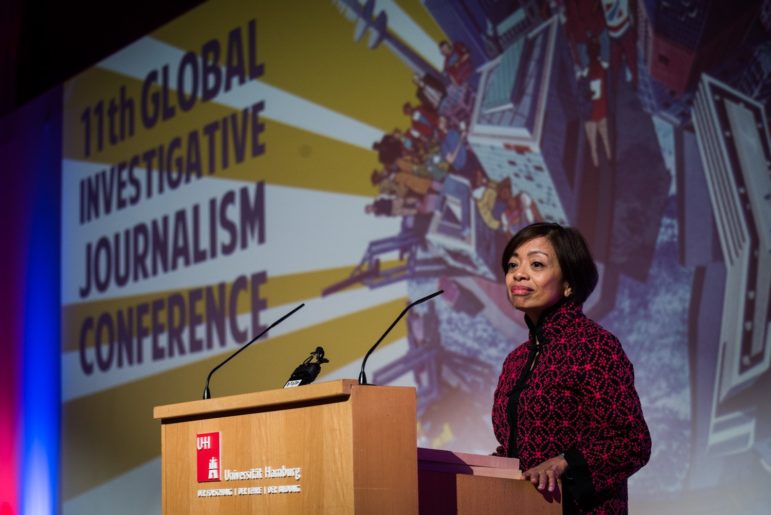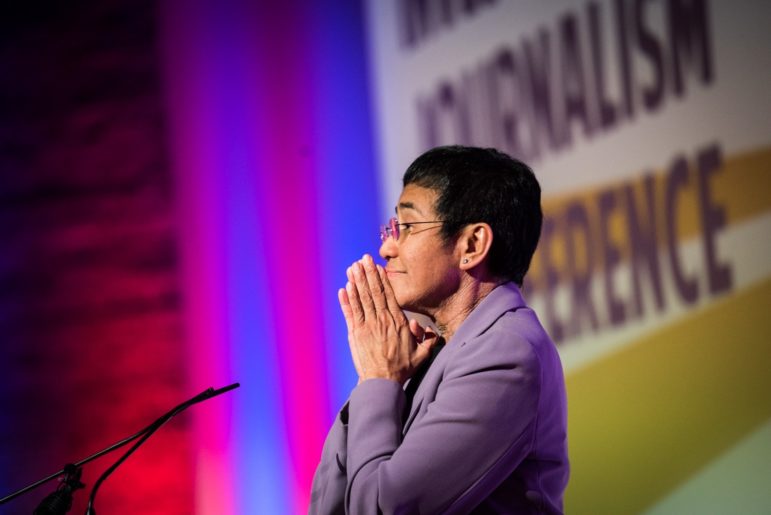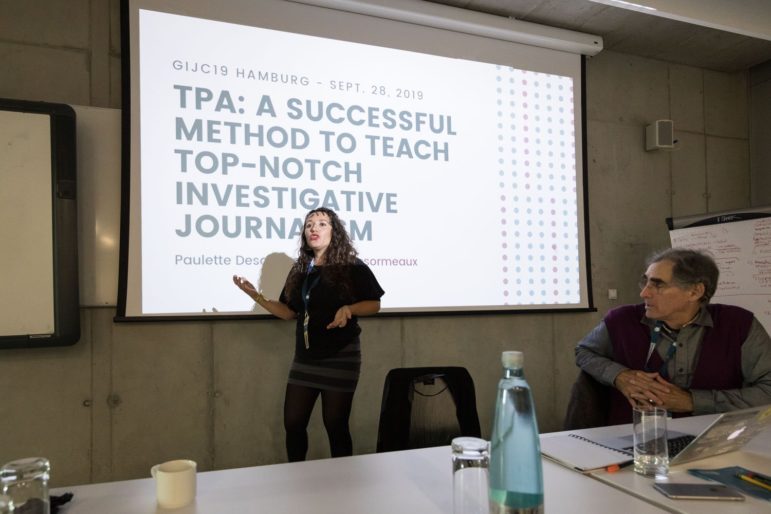

Credit: Nick Jaussi
Chapter 1: Women in Leadership
Guide Resource
Resources for Women Journalists – A GIJN Guide
Chapter Guide Resource
Chapter 1: Women in Leadership
Chapter Guide Resource
Chapter 2: Networks For Women Journalists
Chapter Guide Resource
Chapter 3: Safety, Discrimination & Harassment
Chapter Guide Resource
Chapter 4: Grants, Fellowships, and Awards for Female Journalists
Chapter Guide Resource
Chapter 5: Finding Mentors
Chapter Guide Resource
Chapter 6: Female Experts
Chapter Guide Resource
Chapter 7: Spotlight on Women in Investigative Journalism
Chapter Guide Resource
Chapter 8: Reports on Women’s Issues
Journalism as an industry has been a lonely place for women, and investigative journalism even more so. This has been the consensus at the session titled “Women and Investigative Journalism: Tips on Leadership” at the 12th Global Investigative Journalism Conference (#GIJC21).
The panel was made up of editors at the helm of leading investigative journalism organizations around the world: the UK’s Bureau of Investigative Journalism (TBIJ), Nigeria’s Wole Soyinka Centre for Investigative Journalism, Taiwan’s investigative site The Reporter, the grant-making Pulitzer Center in the United States, and Jordan-based Arab Reporters for Investigative Journalism (ARIJ).
Drawing on decades of collective experience, the panelists detailed how they had risen to the top despite the challenges facing women in many newsrooms. They also pointed out the steps that had allowed them to advocate for themselves and for others in the field. For more, readers can watch the full video of the GIJC21 panel below.
1. Ditch the Lone Wolf Archetype
Rachel Oldroyd, the former managing editor of TBIJ, said that the prevailing image of an investigative reporter being a “lone wolf,” digging away on a story alone, is outdated. She argues that journalists need to let go of this idea and embrace the fact that many women are team players and this can bring its own benefits, especially in terms of collaborative investigative journalism. “We tend to be better at sharing, collaborating, at networking, at empathizing, and all of these skills are extraordinarily important in investigative journalism,” she said, adding that women could also put more emphasis on how important these ideas are to journalism.
2. Know that Not Every Career Is Linear
Marina Walker Guevara, the executive editor at the Pulitzer Center, was working as a senior reporter in Argentina when she decided to move to the United States. At the time, her family thought the move was a step backwards, as she moved from a high-profile reporting position to become an intern at the International Consortium of Investigative Journalists (ICIJ). But as she rose through the ranks, what seemed to some like a gamble paid off: she later became the ICIJ’s deputy director and then the organization’s director of strategic initiatives. She suggests that women embrace the idea that their careers are not always predictable, and notes that work trajectories do not necessarily always follow a straight path or continue in the same direction.
Walker also advises: Careers are a combination of intentionality, serendipity, and pivots. Be ready to be flexible and to embrace new directions in your career, while your eyes remain on the prize (whatever that prize might be). When you find yourself in one of those “pivot” moments in your career, pause and build three lists:
- What am I good at? Your talents, strengths, and superpowers; Ask colleagues to also give you their perspectives.
- What is important to me? Not just in terms of work but more broadly.
- What organizations or teams do I admire and why? Include some that are not in your current field or beat.
3. Find Out if You Suffer from Impostor Syndrome
Impostor syndrome is that internal voice that tells you that you are not good enough or capable enough, even though all evidence about you and your career shows that the opposite is true. Many people suffer from impostor syndrome in our profession, but we rarely talk about it.
Here are a few tips from Walker Guevara to wrestle those internal nagging doubts to the ground:
- Revisit work that you are proud of or a piece of great feedback you received from a colleague, a reader, or a supervisor.
- Maintain a “SWAT team” of colleagues or friends who know you and know your talents. Reach out to them and tell them what you are feeling. (Naming the feelings is a good first step!) They will know what to do.
- Get involved in activities outside of work, whether it is bicycling, boxing, or painting. Develop your non-journalism passions and then bring the resulting energy and sense of accomplishment to your demanding job.
- If you are a manager, one of the best things you can do for your team is provide each person with frequent and specific feedback. This includes your overachievers — they might be battling their own impostor syndrome despite their many accomplishments.
- Practice “institutional disloyalty.” This is a concept I first heard at Stanford University. It doesn’t mean doing harm to the organization you love. On the contrary, it means prioritizing yourself and separating your identity from that of your place of employment so you can be at your best (and healthiest) when you do your important work. Where do you derive your internal validation from? Is it exclusively from work? If this is the case, it might be time for a life pivot.
4. Seek Out Other Women Editors
Oldroyd reminded women to fight so that their perspectives are heard in newsrooms and by commissioning editors, and points out that it is important to tell women-centric stories which in the past have not been given due prominence. She believes this is changing, as recent, global stories centered around women and their experiences are winning awards and getting clicks from audiences, too. She said these award-winning stories could serve as a model and be used by reporters as an example in their newsrooms to advocate for similar work.
5. Use Data to Make Your Case
Motunrayo Alaka, executive director and CEO at the Wole Soyinka Centre, encouraged women to use data for their cause. She told the audience that she had done her own research on the “masculinity of the newsroom” and found that in Nigeria there are two women for every 10 men at the management level, and two women for every seven men at the board level. This, she said, not only allowed her to challenge management, but also to advocate for the hiring of more women for ethical and economic reasons.
6. Call for Help and Support
Oldroyd said that women should also ask for more security and support if that is what they require from newsrooms, especially when working on more sensitive stories such as #MeToo investigations about powerful men and harassment. “Female-centered stories are often very hard and require additional support because you’re talking to very vulnerable sources, such as talking to rape victims or the #MeToo movement,” she said, adding this could lead to “vicarious trauma.” Give yourself a break and take a step back from the fight occasionally.
7. Be Authentic to Your Management Style
Sherry Lee, editor-in-chief of Taiwan’s The Reporter, cautions that it is common for pejorative adjectives like “bossy” or “emotional” to be used to describe women leaders, but not men in the same position. One of her colleagues once told her: “Sherry, you play bad cop really well.” At first, she did not know how to respond but when another colleague used the same words, she knew she had to address it. She told them that as a leader her job was to take responsibility, which was exactly what she was doing. “I also asked them to not refer to me in that way again,” she said, which allowed her to draw a boundary. She believes that different women have different styles of management, which they should embrace rather than change based on newsroom prejudices.
8. Adapt Again and Again
While Walker Guevara emphasized the importance of flexibility at a personal level, ARIJ director-general Rawan Damen focused on adaptability and flexibility at the organizational and professional level. While journalists can always plan, they should also be able to change course when situations demand it. “You need to adapt a lot and you need to plan a lot,” said Damen, stressing that flexibility and having a plan were “two sides of the same coin.”
9. Watch for Burn Out
“Study after study has shown burnout affects more women than men,” noted Walker Guevara, suggesting this could be because of the difference in how men and women set out their priorities. She remembered a time in her own career when she had the words “Failure is not an option” printed on a T-shirt. She said that it was this kind of pressure that can eventually lead to burnout, but that she has realized the importance of learning to say “no,” setting boundaries, and communicating those boundaries.
10. Nurture the Next Generation of Leaders
Alaka said that it is not only important to advocate for yourself but also to encourage and mentor other women. Alongside putting out a call for applications for specific positions, she also looks for women journalists by looking through stories to find potential candidates, talks with female journalists at conferences, and asks other editors to recommend someone they know. “When one woman wins, all women win, because you are able to make way for others,” she said.
Alaka recommends helping women in three major areas: leadership, mainstreaming girls and women into news, and investigative reporting. It is particularly important to get the candidates on projects that help them immediately put to use the lessons learned about leadership and their work as reporters.
11. Remind Male Managers of the Female Perspective
When you find yourself the only woman in a managers’ meeting, Oldroyd advises that you get engaged, make your points, and emphasize to the group that, as the only woman in the room, your perspective is especially important.
Books on Management, Leadership, and Burnout
Below are a number of books that may be useful to reporters and editors taking on leadership positions.
“No Hard Feelings: The Secret Power of Embracing Emotions at Work” by Liz Fosslien and Mollie West Duffy. This cleverly illustrated book will help you understand your and your colleagues’ emotions in the workplace, as well as deal with them. Practical and useful tips help you decide which emotions “to toss, which to keep to yourself, and which to express in order to be both happier and more effective.” More resources from the authors are available on their website, including short guides on difficult conversations and assessments of emotions at work.
“How Women Rise: Break the 12 Habits Holding You Back from Your Next Raise, Promotion, or Job,” by Sally Helgese and Marshall Goldsmith. Publishers say this book will “help women identify specific behaviors that keep them from realizing their full potential, no matter what stage they are in their career. It will also help them identify why what worked for them in the past will not necessarily get them where they want to go in the future – and how to finally shed those behaviors so they can advance to the next level, whatever that may be.” Find more resources from the authors on their website.
“Designing Your Work Life: How to Thrive and Change and Find Happiness at Work” by Bill Burnett and Dave Evans. This book hopes to help readers “transform our work lives and create a dream job that is meaningful without necessarily changing the job we have.”
 “Burnout: The Secret to Unlocking the Stress Cycle” by Emily Nagoski and Amelia Nagoski explores how women experience burnout differently than men. This book provides “a simple, science-based plan to help women minimize stress, manage emotions, and live a more joyful life.”
“Burnout: The Secret to Unlocking the Stress Cycle” by Emily Nagoski and Amelia Nagoski explores how women experience burnout differently than men. This book provides “a simple, science-based plan to help women minimize stress, manage emotions, and live a more joyful life.”
“Difficult Conversations: How to Discuss What Matters Most” by Douglas Stone, Bruce Patton, and Sheila Heen. Based on 15 years of research at the Harvard Negotiation Project, this book walks you through a proven, step-by-step approach to having your toughest conversations with less stress and more success.
“Radical Candor” by Kim Scott. Another bestseller on management, this book preaches “guidance and feedback that’s both kind and clear, specific, and sincere.” The book’s website includes a number of downloadable tips and free videos that managers can use to improve their communications at work.
“Harvard Business Review Guide to Dealing with Conflict” by Amy Gallo. This book claims it will help you understand the most common sources of conflict; explore your options for addressing a disagreement; recognize whether you — and your colleagues — typically seek or avoid conflict; prepare for and engage in difficult conversations; manage your and your colleagues’ emotions; and know the right time to walk away.
“High Conflict: Why We Get Trapped And How to Get Out” by Amanda Ripley. “When we are baffled by the insanity of the ‘other side’ — in our politics, at work, or at home — it’s because we aren’t seeing how the conflict itself has taken over. That’s what ‘high conflict’ does. It’s the invisible hand of our time. It’s what happens when discord distills into a good-versus-evil kind of feud, the kind with an us and a them. In this state, the brain behaves differently. We feel increasingly certain of our own superiority and, at the same time, more and more mystified by the other side. Ripley investigates how good people get captured by high conflict—and how they break free.” 
“Dare to Lead: Brave Work. Tough Conversations. Whole Hearts” by Brene Brown. “Daring leadership in a culture defined by scarcity, fear, and uncertainty requires skill-building around traits that are deeply and uniquely human. The irony is that we’re choosing not to invest in developing the hearts and minds of leaders at the exact same time as we’re scrambling to figure out what we have to offer that machines and AI can’t do better and faster. What can we do better? Empathy, connection, and courage, to start.”
“Work Happy: What Great Bosses Know,” by Gill Geisler. For many years, Geisler directed the leadership and management programs of the Poynter Institute. “This book is for everyone who wants to build the essential skills that help others do their best work. Because of its user-friendly, practical nature, it is especially good for teams of managers who want to learn together.”
Leadership Workshops, Websites, and Additional Resources
Stronger Together: Strategies for Women Investigative Journalists. Women IJs share experiences that highlight the importance of building supportive networks and creating communities of support.
The Poynter Leadership Academy for Women in Media is a program designed for women who directly manage people and are within their first five years of formal leadership experience. You can also subscribe to The Cohort, Poynter’s newsletter for “women kicking ass in digital media and journalism.”
OpenNews is a nonprofit aiming to create a future where newsrooms are anti-racist, equitable, inclusive, and collaborative. Their website is a great resource for managers. Learn more about Open News programs and how you can get involved. Check out the DEI Coalition Slack project management channel, but also read the public resources for more advice on management.
The Management Center offers great advice on how to manage a team successfully. This is a great resource, especially for organizations starting from scratch as it offers various helpful tools for managers, such as evaluation and time managing templates.
The Self-Investigation provides services aimed at improving media professionals’ well-being. It’s led by multilingual, certified coaches and trainers. Co-founder Mar Cabra was an ICIJ investigative journalist, who after winning a Pulitzer Prize in 2017 quit reporting because of burnout. Some of the webinars are free, others cost a few hundred dollars.
Harvard Business Review, the business magazine published by Harvard Business Publishing.
Team Community offers resources for managing nonprofit organizations.
Financial Literacy for Women is a free series of workshops created by the Harvard Kennedy School.
On Female Leadership, Learning, and Paths. A piece on how women can work together to move forward by GIJN’s Deputy Director Gabriela Manuli.
Sincerely, Leaders of Color: It’s Time to Own Our Biases, by Julia B. Chen, is written for everyone in the journalism industry who cares about creating a more supportive environment for journalists of color to do their best work.
Working Women: Valerie Jarrett and the Importance of Mentorship, an episode from the Michelle Obama podcast on mentorship.
The Perils of an Achievement Culture includes several book links to delve more into the topic.
Careers
Videos: Women and Investigative Journalism: Tips on Leadership. GIJN curated this session at the iMEdD International Journalism Forum.
6 Podcasts to Help Navigate Your Career Path. (Paywall)
Embracing your Emotions at Work.
Five Basic Email Templates for Freelancers Negotiating Higher Rates (Kaitlyn Arford)
Journalism Can’t Keep Losing Mothers and Other Family Caregivers (Poynter)
‘Exposure’ Doesn’t Pay the Bills. Here’s How to Get Paid What You’re Worth (NPR)
Organization Culture, Finding the Right Fit When You Are Job Seeking (Impact Opportunity)
Scripts to Move the Conversation Forward on Pay Equity in Journalism. (Online News Association)
On Choosing Abundance (Poynter)
A New Online Resource on Gender in Negotiations (Harvard)
Editor’s Note: A version of this article was published in November 2021, written by GIJN’s Amel Ghani. Later additions are by Gabriela Manuli and Nikolia Apostolou.
















